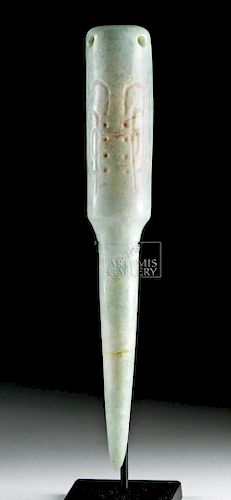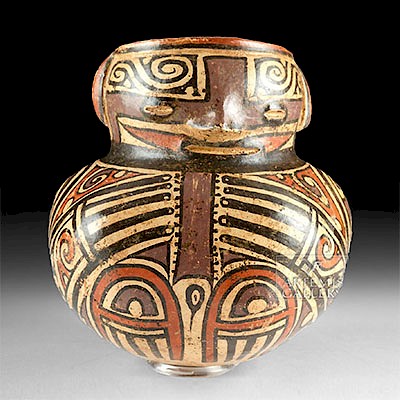Olmec Incised Jade Piercer w/ Cinnabar - Serpent
Lot 58e
About Seller
Artemis Fine Arts
686 S Taylor Ave, Ste 106
Louisville, CO 80027
United States
Selling antiquities, ancient and ethnographic art online since 1993, Artemis Gallery specializes in Classical Antiquities (Egyptian, Greek, Roman, Near Eastern), Asian, Pre-Columbian, African / Tribal / Oceanographic art. Our extensive inventory includes pottery, stone, metal, wood, glass and textil...Read more
Estimate:
$2,200 - $3,300
Absentee vs Live bid
Two ways to bid:
- Leave a max absentee bid and the platform will bid on your behalf up to your maximum bid during the live auction.
- Bid live during the auction and your bids will be submitted real-time to the auctioneer.
Bid Increments
| Price | Bid Increment |
|---|---|
| $0 | $25 |
| $300 | $50 |
| $1,000 | $100 |
| $2,000 | $250 |
| $5,000 | $500 |
| $10,000 | $1,000 |
| $20,000 | $2,500 |
| $50,000 | $5,000 |
| $100,000 | $10,000 |
| $200,000 | $20,000 |
About Auction
By Artemis Fine Arts
Nov 8, 2018
Set Reminder
2018-11-08 10:00:00
2018-11-08 10:00:00
America/New_York
Bidsquare
Bidsquare : Ancient / Ethnographic From Around The World
https://www.bidsquare.com/auctions/artemis-gallery/ancient-ethnographic-from-around-the-world-3598
Ancient art from Egypt, Greece, Italy and the Near East, as well as Asian, Pre-Columbian, Native American, African / Tribal / Oceanic, Spanish Colonial, Russian Icons, Fine art, much more! Artemis Fine Arts info@artemisfinearts.com
Ancient art from Egypt, Greece, Italy and the Near East, as well as Asian, Pre-Columbian, Native American, African / Tribal / Oceanic, Spanish Colonial, Russian Icons, Fine art, much more! Artemis Fine Arts info@artemisfinearts.com
- Lot Description
Pre-Columbian, Olmec culture, ca. 1150 to 550 BCE. A gorgeous pale blue-green jade piercer made for bloodletting with a simple form that is shaped like a serpent whose body dramatically narrows and foreshortens into the piercing spike at its tail. A drilled hole in the wider part of the body would allow this to be worn or to be attached to a belt. The serpent's head is enhanced by lightly incised motifs, including eyes, a long mouth with a curved snout, and eight dots atop the head, perhaps meant to replicate scales. These dots are colored with pale red cinnabar; the other incised eyes may have been similarly colored once. Size: 0.95" W x 6.4" H (2.4 cm x 16.3 cm); 6.95" H (17.7 cm) on included custom stand.
Unlike the later Maya, we have not found any representations of ritual bloodletting in Olmec art. However, jade and ceramic perforators as well as representations of such paraphernalia on stelae and in iconography provide evidence of its practice among the Olmec. For example, a translation of the Epi-Olmec culture's La Mojarra Stela 1 tell of the ruler's ritual bloodletting. The value of jade for ancient people lay in its symbolic power: perhaps its color was associated with water and vegetation; later, the Maya would place jade beads in the mouths of the dead. Many scholars have argued that the demand for jadeite contributed to the rise of long distance trading networks and to the rise of urban centers in ancient Mesoamerica. This would have been an exceedingly valuable and rare piece of ceremonial art.
Provenance: private Newport Beach, California, USA collection
All items legal to buy/sell under U.S. Statute covering cultural patrimony Code 2600, CHAPTER 14, and are guaranteed to be as described or your money back.
A Certificate of Authenticity will accompany all winning bids.
We ship worldwide and handle all shipping in-house for your convenience.
#135839Light wear to surface commensurate with age and handling. Nice preservation of motifs. Some of the original cinnabar pigment remains.Condition
- Shipping Info
-
All shipping is handled in-house for your convenience. Your invoice from Artemis Gallery will include shipping calculation instructions. If in doubt, please inquire BEFORE bidding for estimated shipping costs for individual items.
-
- Buyer's Premium



 EUR
EUR CAD
CAD AUD
AUD GBP
GBP MXN
MXN HKD
HKD CNY
CNY MYR
MYR SEK
SEK SGD
SGD CHF
CHF THB
THB















